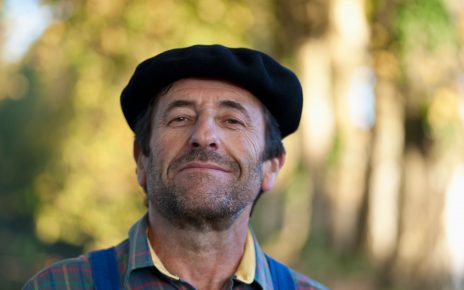
In the spring of 2020, as COVID was ravaging communities across the globe, word spread to the village of Culden, Peru, that the virus that causes COVID originated in bats. Mistakenly believing that the animals spread the virus to humans, inhabitants of the village burned a nearby colony of mouse-eared bats, intent on extermination.
During the pandemic, culling bats became common practice across the world—in a time when their habitats are already under grave existential threat. Bat populations are falling globally. Ironically, scientists theorize that the destruction of bats and their habitats may cause more disease outbreaks. But the impacts of the loss of bat species reach far beyond disease: bats serve crucial ecological roles in the most biodiverse regions of the world.
“For millennia, bats have been associated with evil and darkness. People don’t know them, and it’s easy to fear what you don’t know,” says Adrià López-Baucells, a senior researcher at the Museum of Natural Sciences of Granollers, in Barcelona. “They have an incredible amount of functions that all help to maintain the fragile equilibrium of their ecosystems.”
According to a new paper published in Perspectives in Ecology and Conservation, threatened and endangered bat species have thrived in territories where Indigenous peoples have exclusive land rights. Some threatened bat species live entirely in Indigenous territories, where deforestation is lower than even in some protected areas.
“Deforestation is tremendous. It is one of the most important threats to bats … and it’s increasing,” says López-Baucells, one of the co-authors of the paper.
Across the Amazon, logging, gold mining and agriculture are encroaching on Indigenous territories, forcing Indigenous people off their land. These commercial forces are destroying the biodiverse dense jungles and forests that Indigenous people have stewarded for millennia, and are making bat habitats more homogeneous. Bats are vulnerable to the loss of the trees where they make their nests.
As a result, threatened and endangered bat species are disappearing.
One of these species is the Marinkelle’s sword-nosed bat, which uses its unicornlike horn to swoop insects out of the air. It has been found almost entirely in Indigenous territories.
Night after night in the pitch-black jungle, López-Baucells captures bats in the field around the world. Bats fill important ecological roles based on what they eat. Large-nosed fruit-bats sink their teeth into large, ripe fruit, dispersing the seeds and pollinating plants. Insect-eaters expertly capture disease-bearing bugs, consuming pests by the literal ton. The mouse-eared bats burned in Peru, for example, hunt the mosquitoes that transmit diseases like malaria.
The fate of these bats is inextricably tied to that of Indigenous communities. For millennia, Indigenous people have lived in and stewarded 80 percent of the planet’s biodiversity. Indigenous practices play a role in not just preserving but enhancing bat biodiversity. Indigenous people have marked impacts in shaping their environments through generations of forest management, traditional hunting practices and crop cultivation. The idea that the Amazon is a pristine, untouched natural habitat is a myth. In fact, the Amazon is a hub of cultural diversity as well as biodiversity, and Indigenous people have historically taken a large role in maintaining the ecosystem of the Amazon.
López-Baucells and his colleagues used data from the International Union of the Conservation of Nature (IUCN) to map the territories where bat species are located, and from the Amazon Geo-Referenced Socio-Environmental Information Network (RAISG), which lists the boundaries of Indigenous territories. Of the 223 bat species in the Amazon, the researchers found that the habitats of 22 had a quarter of their range within Indigenous territories. Some Indigenous territories were home to over half of the bat species in the Amazon. Some rare and threatened species had only been found within the boundaries of Indigenous territories.
“Globally, Indigenous peoples are at the forefront not only of protecting the environment, but as stewards of a long-term legacy of managing and shaping biodiversity, agrobiodiversity and protecting watersheds; they are central to keeping alive a large share of agrobiodiversity upon which we all depend,” says Eduardo Brondizio, an anthropologist at the University of Indiana at Bloomington. “In the Amazon, for instance, it is well documented [that] they have managed, maintained and contributed to shape the incredible biodiversity and agrobiodiversity of the Amazon.”
López-Baucells hopes that the data set, which includes a list of bat species and what percentage of their distributions can be found in Indigenous territories, will be used as a tool to make important decisions about conservation with local land managers, policy makers and other stakeholders involving Indigenous groups.
“We wanted to create something that could be brought right to the table where decisions about conservation are made. It’s clear that, for future research and conservation, we need to interact more with [local leaders and researchers] and with Indigenous peoples—not acting as Western researchers alone,” says López-Baucells, “It’s conservation that is born with and from the people that [are] living there.”
Indigenous people are rarely given a voice in public policy. Because of that legacy of neglect and discrimination, some argue that engaging Indigenous people only as conservationists isn’t the right approach.
“We need to acknowledge that Indigenous rights are important for their own sake, independent of their contribution to nature conservation goals,” says Brondizo. Though, broadly, Indigenous people have a unique, symbiotic relationship with nature, he adds that their needs need to be recognized first. “We need to recognize that Indigenous people are diverse and live in different societal contexts, in most cases lacking proper and culturally appropriate access to health and education, as well as a voice in public policies.”
Indigenous people are fighting for land-use rights all over the Amazon, including in the largest Indigenous territory in the world, the Kayapo territory. At the border of the Kayapo region in Brazil’s Pará and Mato Grosso states, cattle pasture gives way to dense forest. Although Indigenous people have exclusive use rights of their land under the Brazilian constitution, under President Jair Bolsonaro, the Brazilian government has openly declared its intention to not enforce Indigenous groups’ exclusive rights along the southern border of this territory, leaving it vulnerable to encroachment by opportunistic forces that want to log, raze pastures and mine for gold on Indigenous land. Faced with an actively hostile government, Indigenous NGOs are one of the only ways for the Kayapo to bring in outside resources for border protection.
“The southeastern Kayapo border is essentially lawless,” says Barbara Zimmerman, a conservation researcher at the University of Toronto, who directs the Environmental Defense Fund’s contribution to the Kayapo Project. ”The government is actively trying to take over Indigenous land and destroy Indigenous NGOs that fund crucial border protection services. Without them, the Kayapo people would no longer be there…. They would have been wiped out.”
Though Zimmerman reports that most Kayapo have been spared from COVID-19, many other indigenous communities have not. The coronavirus has killed Indigenous people at almost double the rate of other South Americans. Most Indigenous communities have been forced into isolation to contain spread, and outside forces have exploited the opportunity to push further into Indigenous territories.
“It is not just pandemics…. If we don’t change the roots of how humans are treating the planet, not only are pandemics going to keep coming, but we’re going to lose a whole world of animals and plants,” says López-Baucells.
This is an opinion and analysis article; the views expressed by the author or authors are not necessarily those of Scientific American.


